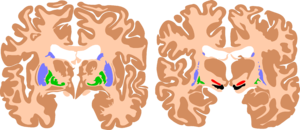Athetoid cerebral palsy
| Dyskinetic cerebral palsy | |
|---|---|
 |
|
| The basal ganglia are instrumental in motor function. Damage to these areas results in athetoid/ dyskinetic cerebral palsy (ADCP). | |
| Classification and external resources | |
| Specialty | neurology |
| ICD-10 | G80.3 |
| ICD-9-CM | 343 |
| OMIM | 603513 605388, 612900 |
| DiseasesDB | 2232 |
| MedlinePlus | 000716 |
| eMedicine | neuro/533 pmr/24 |
| MeSH | D002547 |
Athetoid cerebral palsy or dyskinetic cerebral palsy (sometimes abbreviated ADCP) is a type of cerebral palsy primarily associated with damage, like other forms of CP, to the basal ganglia in the form of lesions that occur during brain development due to bilirubin encephalopathy and hypoxic-ischemic brain injury. Unlike spastic or ataxic cerebral palsies, ADCP is characterized by both hypertonia and hypotonia, due to the affected individual's inability to control muscle tone. Clinical diagnosis of ADCP typically occurs within 18 months of birth and is primarily based upon motor function and neuroimaging techniques. While there are no cures for ADCP, some drug therapies as well as speech, occupational therapy, and physical therapy have shown capacity for treating the symptoms.
Classification of cerebral palsy can be based on severity, topographic distribution, or motor function. Severity is typically assessed via the Gross Motor Function Classification System (GMFCS) or the International Classification of Functioning, Disability and Health (described further below). Classification based on motor characteristics classifies CP as occurring from damage to either the corticospinal pathway or extrapyramidal regions. Athetoid dyskinetic cerebral palsy is a non-spastic, extrapyramidal form of cerebral palsy (spastic cerebral palsy, in contrast, results from damage to the brain’s corticospinal pathways). Non-spastic cerebral palsy is divided into two groups, ataxic and dyskinetic. Dyskinetic cerebral palsy is separated further into two different groups; choreoathetoid and dystonic. Choreo-athetotic CP is characterized by involuntary movements most predominantly found in the face and extremities. Dystonic ADCP is characterized by slow, strong contractions, which may occur locally or encompass the whole body.
...
Wikipedia
